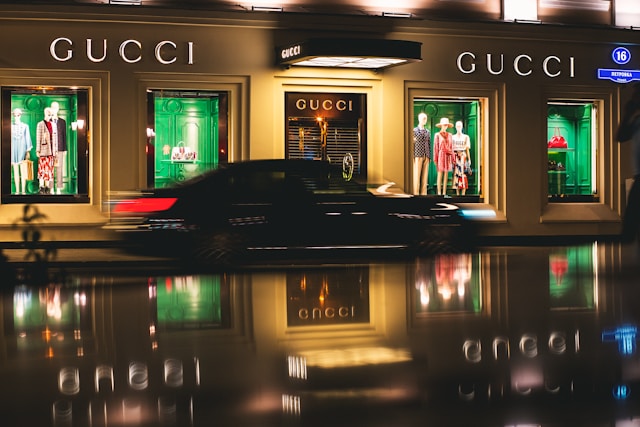Few names resonate amongst fashionistas with as much reverence and allure as Gucci. A brand steeped in tradition, yet perpetually at the forefront of innovation, Gucci has deftly balanced the preservation of its storied heritage with the audacious reinvention of its identity. For marketing professionals eager to glean insights from the crème de la crème of the fashion world, Gucci’s marketing strategy offers a masterclass in both artistry and acumen.
The Fusion of Heritage and Innovation
Gucci’s marketing strategy is rooted in a delicate balance between honoring its rich heritage and embracing avant-garde innovation. Founded in Florence in 1921 by Guccio Gucci, the brand’s early years were marked by a dedication to quality craftsmanship and opulence, themes that have remained central to its identity. Yet, it is Gucci’s ability to continually reinvent itself that has kept it relevant across generations.

Under the creative direction of Alessandro Michele since 2015, Gucci has undergone a radical transformation. Michele’s vision has injected the brand with a fresh, eclectic aesthetic that has captivated a younger audience while still appealing to long-time aficionados. This blend of the old and the new is central to Gucci’s marketing narrative, celebrating its legacy while pushing the boundaries of contemporary fashion.
Storytelling and Brand Narrative
At the heart of Gucci’s marketing success is its prowess in storytelling. Every campaign is meticulously crafted to weave a rich narrative that transcends mere product promotion. These narratives often draw on themes of fantasy, history, and pop culture, creating a tapestry that is both visually stunning and emotionally resonant.
Take, for example, the “Gucci Guilty” fragrance campaign. This series of advertisements is less about the scent itself and more about the stories and emotions it evokes. Featuring high-profile celebrities like Jared Leto and Lana Del Rey, the campaign conjures a retro Hollywood fantasy, dripping with glamour and intrigue. By positioning the fragrance within this evocative context, Gucci elevates the product into a symbol of a desired lifestyle.

Digital Mastery and Social Media Savvy
In today’s digital age, a brand’s online presence can be a make-or-break factor. Gucci has not only embraced digital platforms but has excelled in leveraging them to create immersive, engaging experiences. Their social media strategy is a textbook example of how to build and sustain a strong online community.
Gucci’s Instagram account, boasting over 50 million followers, serves as a digital mood board that reflects Michele’s eclectic vision. The brand uses Instagram to share everything from campaign images and product shots to behind-the-scenes glimpses and user-generated content. This diverse array of content keeps followers engaged and invested in the brand’s journey.
Moreover, Gucci has tapped into the power of influencer marketing with great effect. By collaborating with influencers who embody the brand’s ethos, Gucci extends its reach to new audiences. These partnerships are not just about celebrity endorsements; they are carefully curated relationships that enhance the brand narrative.
Immersive Retail Experiences
While the digital channel is crucial, Gucci has not neglected the power of physical retail. Their stores are designed to be more than just points of sale; they are immersive environments that reflect the brand’s aesthetic and values. The Gucci Garden in Florence, for instance, is a multi-sensory experience that combines a museum, boutique, and restaurant. Visitors can explore the brand’s history, shop exclusive collections, and even dine in a setting that encapsulates the Gucci universe.
This approach transforms shopping into an experience, making customers feel like they are part of something special. It’s a strategy that not only drives sales but also fosters deep brand loyalty.
Bold and Provocative Campaigns
Gucci is unafraid to push boundaries and challenge conventions, a trait that has set its marketing campaigns apart. One of the most notable examples is the “Gucci Bloom” campaign, which celebrated diversity and individuality. Featuring a cast of models that included actress Dakota Johnson and artist Petra Collins, the campaign was a vibrant celebration of natural beauty and personal expression.

The “Gucci Pre-Fall 2019” campaign, on the other hand, took a bold stand on social issues. Titled “Gucci Gothic,” the campaign featured an inclusive cast of models set against a hauntingly beautiful backdrop. The imagery was both provocative and thought-provoking, sparking conversations about representation in the fashion industry.
By addressing social and cultural issues head-on, Gucci positions itself as not just a fashion brand, but a cultural commentator. This not only attracts attention but also aligns the brand with the values of its audience, particularly younger consumers who prioritize authenticity and social responsibility.
Personalization and Customer Engagement
In the luxury market, personalization is key to creating a unique customer experience. Gucci has excelled in this area by offering bespoke services that cater to individual preferences. The “Gucci DIY” (Do It Yourself) service allows customers to customize a selection of products, adding their personal touch to iconic designs. This level of personalization not only enhances the customer experience but also deepens the emotional connection to the brand.
Additionally, Gucci has embraced the power of data to enhance customer engagement. By leveraging data analytics, the brand can offer personalized recommendations and targeted marketing messages that resonate with individual customers. This data-driven approach ensures that marketing efforts are both efficient and effective.
Collaborations and Cross-Industry Partnerships
Gucci’s collaborations are a testament to its innovative spirit and willingness to think outside the box. By partnering with brands and artists from various industries, Gucci creates unique, buzz-worthy products that capture the imagination of the public.
One of the most notable collaborations was with The North Face, a brand seemingly at odds with Gucci’s luxury image. However, this partnership resulted in a collection that seamlessly blended the aesthetics of both brands, appealing to fashion-forward consumers who appreciate both luxury and functionality. The collaboration was a resounding success, generating significant media coverage and consumer interest.
Gucci has also ventured into the digital realm with its collaboration with the online game “The Sims.” By creating virtual Gucci items for the game, the brand tapped into the growing trend of digital fashion and expanded its reach to a tech-savvy audience. This innovative approach demonstrates Gucci’s ability to stay ahead of the curve and adapt to changing consumer behaviors.
Sustainability and Social Responsibility
In recent years, sustainability has become a critical issue in the fashion industry, and Gucci has made significant strides in this area. The brand’s commitment to sustainability is evident in initiatives like “Gucci Equilibrium,” a platform dedicated to fostering positive change for people and the planet.
Gucci has pledged to reduce its environmental impact through measures such as using sustainable materials, reducing carbon emissions, and ensuring ethical practices throughout its supply chain. The brand’s efforts have been recognized with certifications such as the Global Organic Textile Standard (GOTS) and the Responsible Wool Standard (RWS).
By integrating sustainability into its core values, Gucci not only addresses a critical global issue but also aligns itself with the values of its consumers. This commitment to social responsibility enhances the brand’s reputation and builds trust with its audience.
The Power of Iconography
Gucci’s marketing strategy also relies heavily on the power of iconography. The brand’s iconic symbols, such as the interlocking GG logo and the green-red-green stripe, are instantly recognizable and have become synonymous with luxury and sophistication. These symbols are consistently featured across Gucci’s products and marketing materials, reinforcing brand recognition and loyalty.
Moreover, Gucci has adeptly utilized iconic imagery in its advertising campaigns. The use of striking visuals, often featuring bold colors and unconventional compositions, ensures that Gucci’s advertisements stand out in a crowded market. These visuals not only capture attention but also evoke an emotional response, making them memorable and impactful.
The Role of Celebrity Endorsements
Celebrity endorsements have long been a staple in the world of luxury fashion, and Gucci has masterfully leveraged this tactic to enhance its brand image. By collaborating with celebrities who embody the brand’s values and aesthetic, Gucci creates a powerful association between its products and aspirational lifestyles.
One of the most high-profile examples is Gucci’s partnership with Harry Styles. The British singer, known for his eclectic and flamboyant style, perfectly aligns with Alessandro Michele’s vision for the brand. Styles has been featured in several Gucci campaigns, including the “Gucci Tailoring” campaign, where he is seen wearing bespoke suits in opulent settings. This collaboration has not only attracted media attention but also resonated with a younger audience, further cementing Gucci’s status as a forward-thinking brand.
Engagement through Digital Campaigns
In the digital age, engaging content is crucial for maintaining consumer interest, and Gucci has excelled in creating compelling digital campaigns. The brand’s use of video content, in particular, has been a standout element of its strategy.
The “Gucci Gift 2020” campaign, for instance, featured a series of short films that showcased the brand’s holiday collection in a whimsical and fantastical manner. These films, shared across social media and digital platforms, were not only visually captivating but also encouraged viewer interaction. By inviting consumers to engage with the content, Gucci created a more immersive and participatory experience.
Additionally, Gucci has embraced the power of user-generated content (UGC) to foster a sense of community among its audience. The brand often encourages followers to share their own Gucci-inspired looks and experiences on social media, using branded hashtags like #GucciCommunity. This UGC not only provides authentic and relatable content but also strengthens the bond between the brand and its consumers.
Leveraging Data and Technology
In today’s data-driven world, leveraging technology and analytics is essential for effective marketing. Gucci has harnessed the power of data to enhance its marketing efforts and provide a more personalized customer experience.
Through the use of customer relationship management (CRM) systems, Gucci can track consumer preferences and behaviors, allowing for targeted marketing campaigns that resonate with individual customers. This data-driven approach ensures that marketing messages are relevant and timely, increasing their effectiveness.
Moreover, Gucci has embraced emerging technologies such as augmented reality (AR) and virtual reality (VR) to create unique and immersive experiences. The “Gucci AR Sneakers” campaign, for instance, allowed customers to virtually try on sneakers using AR technology. This innovative approach not only enhanced the shopping experience but also demonstrated Gucci’s commitment to embracing cutting-edge technology.
Adaptability and Resilience
One of the most admirable aspects of Gucci’s marketing strategy is its adaptability and resilience in the face of challenges. The COVID-19 pandemic, for instance, posed significant disruptions to the fashion industry, but Gucci quickly adapted its marketing efforts to the new reality.
During the pandemic, Gucci shifted its focus to digital channels, increasing its online presence and engaging with consumers through virtual events and social media campaigns. The brand also launched the “Gucci Live” service, a virtual shopping experience that allowed customers to connect with sales associates via video calls. This innovative approach ensured that Gucci could continue to provide a high level of customer service despite physical store closures.
Lessons for Marketers from Gucci
Gucci’s marketing strategy is a testament to the power of creativity, innovation, and authenticity. For marketing professionals, there are several key takeaways from Gucci’s success:
- Balancing Heritage and Innovation: Embrace your brand’s history while continually evolving to stay relevant.
- Storytelling: Craft compelling narratives that resonate emotionally with your audience.
- Digital Mastery: Leverage digital platforms to create engaging and immersive experiences.
- Bold Campaigns: Don’t be afraid to challenge conventions and address social issues.
- Personalization: Offer personalized experiences that deepen the customer’s connection to the brand.
- Collaborations: Partner with other brands and artists to create unique and buzz-worthy products.
- Sustainability: Commit to social responsibility and align your brand with the values of your consumers.
- Iconography: Use iconic symbols to reinforce brand recognition and loyalty.
- Celebrity Endorsements: Collaborate with celebrities who embody your brand’s values.
- Adaptability: Be resilient and adaptable in the face of challenges.
Gucci’s marketing strategy is a brilliant fusion of art and science, creativity and data, tradition and innovation. It is a blueprint for success that marketers can draw inspiration from as they navigate the ever-changing landscape of the fashion industry. By learning from Gucci’s example, brands can craft their own stories of success and create lasting connections with their audiences.

